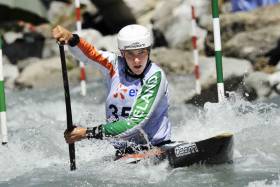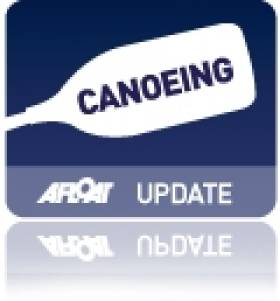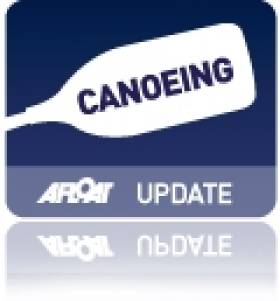Displaying items by tag: Slalom
Heurteau Misses Chance of Olympic Qualification
#Canoeing: Ciarán Heurteau finished 16th in his second run of the K1 at the European Championships in Slovakia and missed out on a place in the semi-final, and the possibility of claiming a place at the Olympics. Heurteau had a poor first run, missing gate seven and incurring a 50-second penalty. His second-run time of 100.52 seconds was much better, but he would have had to finish in the top 10 to progress. Elliott Davidson placed 58th and 20th in his two runs.
Ireland International Places on the Line at Lucan
#Canoeing: The top Irish competitors in canoe slalom will be in action at the Irish Championships at the Sluice Weir in Lucan this Saturday and Sunday, March 5th and 6th. The races at the redeveloped Sluice Weir in the Lucan Demesne/St Catherine’s Park, will double as selection races for the Ireland senior and junior international teams for:
- The Senior European Championships in Liptovsky Mikulas, (Slovakia) in May.
- The five-event World Cup series in Ivrea (Italy), La Seu d’Urgell (Spain) and Pau (France) in June and in Prague (Czech Republic) and Tacen (Slovenia) in August.
- Junior and Under 23 World Championships in Krakow (Poland) in July and European Championships in Solkan (Slovenia) at the end of August.
The Senior European Championships in Liptovsky Mikulas will also count as the final qualification event for places at the Olympic Games. Only one place is available in each class to European countries who have not yet qualified.
Racing on both days will feature London 2012 K1 finalist Hannah Craig, who is entering her second season back to competition following the birth of her son Arlo in May 2014. Hannah has spent the winter at the artificial whitewater course in Nottingham, England in preparation for the 2016 season.
Competing in the C1 category will be Liam Jegou who took 6th place in the Under 23 European Championships in Krakow last year and got semi-final placings in two of his three World Cup races and in the World Championships in his first season of senior races. He has just completed a winter-training bloc on the artificial whitewater course in Al Ain, Dubai.
Robert Hendrick will double-up with his brother Noel in the Under 23 C2 class over the weekend, having taken 4th place in the Junior World Championships in Brazil last year.
In the K1M class, Ciarán Heurteau is coming back to Ireland from a two-month intensive winter training bloc in New Zealand to compete for a place at the European Champs and Olympic qualifier after being out of competition last season due to an anterior cruciate ligament injury which required surgery and rehabilitation.
To provide a good benchmark to assess selection performance levels, Canoe Slalom Ireland are bringing in Mike Kurt (30th in men’s kayak world rankings and semi-finalist in the 2015 World Championships) from Switzerland. The Welsh junior and under-23 team will also take part.
Ryan Best of Irish K1 Competitors at Canoe Slalom World Championships
#Canoeing: Cade Ryan was the most impressive of Ireland’s three competitors in the K1 at the canoe slalom World Championships in Lee Valley in England today. Ryan clocked 90.42 seconds and 89.69 in the two runs, with no penalties on either. Elliott Davidson and Sam Curtis were pushed well down the rankings, through penalties on both runs.
Canoe Slalom World Championships, Lee Valley, London, Day Three (Irish interest)
Men
K1 – First Run (top 30 to Semi-Finals): 60 C Ryan 90.42; 98 S Curtis 145.17 (incl 54 seconds penalty); 102 E Davidson 203.59 (incl 104 sec pen). Second Run (10 qualify): 27 Ryan 89.69; 41 Davidson 99.06 (incl 6 sec pen); 65 Curtis 146.05 (incl 56 sec pen).
Hendrick Twins Place Fourth in World in Brazil
#CANOEING: Noel and Robert Hendrick narrowly missed a podium finish at the Junior and Under-23 Canoe Slalom World Championships in Brazil. The twin brothers, competing in a Junior C2 (Canadian canoe), finished fourth behind French, Czech and German pairings. The Hendricks compete for Ribbontail Canoe Club in Enfield in County Meath. Three Ireland competitors exited at the semi-final stage: Jake Cochrane (C1, Under-23), Aisling Conlan (K1, Under-23) and Robert Hendrick (C1 Junior). The Hendrick brothers are set to compete at the European Junior and Under-23 Canoe Slalom Championships in Poland next August.
ICF Canoe Slalom Junior and Under-23 World Championships, Foz do Iguassu, Brazil (Selected Results) – C2 Men, Junior: 1 France 104.25 seconds, 2 Czech Republic 101.64, 3 Germany 105.55; 4 Ireland (N Hendrick, R Hendrick) 109.91.
Ireland Canoeist Rheinisch Starts Well in Tacen World Cup
#CanoeSlalomTacen: Eoin Rheinisch started well at the Canoe Slalom World Cup in Tacen this morning. The Ireland paddler had a clear first run in a time of 102.21, placing him fourth in the K1 competition at this very early stage. Ciarán Heurteau was judged to have had a touch at gate four, adding a two-second penatly to his time of 104.77, and leaving him down the rankings. Patrick Hynes had a run of 123.17, including 10 seconds in penalties. The second run is due later today.
Heurteau Sole Irish Qualifier at Augsburg World Cup
# CANOE SLALOM WORLD CUP: Ciaran Heurteau was Ireland’s sole qualifier for the semi-finals on the first day of the canoe slalom World Cup in Augsburg, Germany. Heurteau, who has an Irish mother but was brought up near Paris, secured his place with his first run, and finished 23rd of the 40 qualifiers on a difficult course. Eoin Rheinisch placed 49th, missing a semi-final for the second successive World Cup. He also missed out in Cardiff.
Liam Jegou, who is just 17, did well but was disappointed with placing 44th in the men’s C1. Hannah Craig fell ill and did not compete in the women’s K1.
Canoe Slalom World Cup, Augsburg, Germany, Day One (Irish interest)
Men
K1 – Heats (First 40 Qualify for Semi-Finals): 1 Slovenia (P Kauzer) 98.22 secs; 23 C Heurteau 104.42 (incl 2 sec pen; 1st run); 49 E Rheinisch 107.52 (2nd run); 61 P Hynes 114.76 (2nd Run);
C1 – Heats (First 20 Qualify): 44 L Jegou 118.32 (incl 4 sec pen; 2nd run).
Women
K1 – Heats: H Craig did not start.
Heurteau's London 2012 Bid Comes Up Short at Canoe Slalom World Championships
Ireland’s Ciaran Heurteau finished 28th in the K1 semi-finals at the Canoe Slalom World Championships this morning in Bratislava in Slovakia. The top 10 go to the final, but a place in the top 15 countries would have qualified the boat for London 2012. Heurteau’s placing fell outside this mark.
Canoe Slalom World Championships, Bratislava, Slovakia
Men's Semi-Finals (Irish interest) – K1 (First 10 to Final; first 15 countries qualify for London Olympics): 1 France (B Neveu) 94.40; 28 C Heurteau 104.99 (9.59 behind).





























































